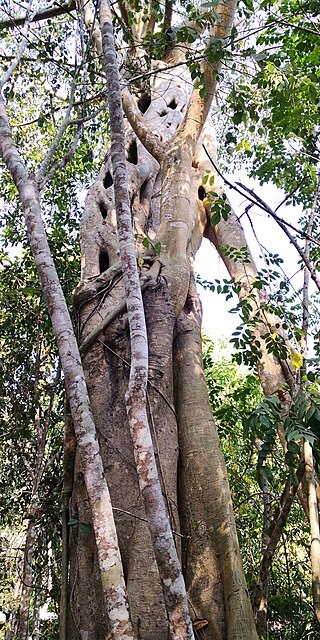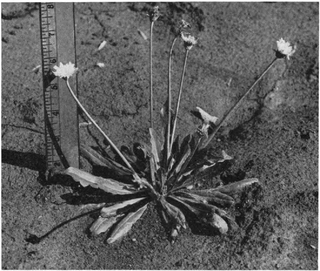
Ficus is a genus of about 850 species of woody trees, shrubs, vines, epiphytes and hemiepiphytes in the family Moraceae. Collectively known as fig trees or figs, they are native throughout the tropics with a few species extending into the semi-warm temperate zone. The common fig (F. carica) is a temperate species native to southwest Asia and the Mediterranean region, which has been widely cultivated from ancient times for its fruit, also referred to as figs. The fruit of most other species are also edible though they are usually of only local economic importance or eaten as bushfood. However, they are extremely important food resources for wildlife. Figs are also of considerable cultural importance throughout the tropics, both as objects of worship and for their many practical uses.

Hevea brasiliensis, the Pará rubber tree, sharinga tree, seringueira, or most commonly, rubber tree or rubber plant, is a flowering plant belonging to the spurge family Euphorbiaceae originally native to the Amazon basin, but is now pantropical in distribution due to introductions. It is the most economically important member of the genus Hevea because the milky latex extracted from the tree is the primary source of natural rubber.

Ficus benjamina, commonly known as weeping fig, benjamin fig or ficus tree, and often sold in stores as just ficus, is a species of flowering plant in the family Moraceae, native to Asia and Australia. It is the official tree of Bangkok. The species is also naturalized in the West Indies and in the states of Florida and Arizona in the United States. It is one of the most common trees in Israeli cities and parks. In its native range, its small fruit are favored by some birds.

Aerial roots are roots above the ground. They are almost always adventitious. They are found in diverse plant species, including epiphytes such as orchids (Orchidaceae), tropical coastal swamp trees such as mangroves, banyan figs, the warm-temperate rainforest rata, and pohutukawa trees of New Zealand. Vines such as common ivy and poison ivy also have aerial roots.

Ficus microcarpa, also known as Chinese banyan, Malayan banyan, Indian laurel, curtain fig, or gajumaru (ガジュマル), is a tree in the fig family Moraceae. It is native in a range from China through tropical Asia and the Caroline Islands to Australia. It is widely planted as a shade tree and frequently misidentified as F. retusa or as F. nitida.

Ficus citrifolia, also known as the shortleaf fig, giant bearded fig, Jagüey, wild banyantree and Wimba tree, is a species of banyan native to southern Florida, the Caribbean, Mexico, Central America, and northern South America south to Paraguay. It is distinguished from the closely related Florida strangler fig mainly by the finer veining in the leaves.

Ficus lyrata, commonly known as the fiddle-leaf fig, banjo fig, fiddle-leaved fig tree, lyre leaf fig tree, or lyre-leaved fig tree, is a species of plant in the mulberry and fig family Moraceae. It is native to western Africa, but is cultivated around the world as an ornamental plant. It has received the Royal Horticultural Society's Award of Garden Merit.

Codiaeum variegatum is a species of plant in the genus Codiaeum, which is a member of the family Euphorbiaceae. It was described by Carl Linnaeus in 1753. It is native to Indonesia, Malaysia, Australia, and the western Pacific Ocean islands, growing in open forests and scrub.

Ficus pumila, commonly known as the creeping fig or climbing fig, is a species of flowering plant in the mulberry family, native to East Asia and naturalized in parts of the southeastern and south-central United States. It is also found in cultivation as a houseplant. The Latin specific epithet pumila means "dwarf", and refers to the very small leaves of the plant.

Ficus maclellandii is a species of fig plant native to India, Southeast Asia and China. It is an evergreen often grown as a houseplant in temperate climates. The leaves are 8–13 cm and uniquely dimorphic; with narrow leaves on the lower, sterile branches and broader leaves on the higher branches.

Taraxacum kok-saghyz, often abbreviated as TKS and commonly referred to as the Kazakh dandelion, rubber root, or Russian dandelion, is a species of dandelion native to Kazakhstan, Kyrgyzstan and Uzbekistan, notable for its production of high-quality rubber. T. kok-saghyz was discovered in Kazakhstan in 1932 by Soviet scientists seeking a domestic source of rubber.

The fig is the edible fruit of Ficus carica, a species of small tree in the flowering plant family Moraceae, native to the Mediterranean region, together with western and southern Asia. It has been cultivated since ancient times and is now widely grown throughout the world. Ficus carica is the type species of the genus Ficus, containing over 800 tropical and subtropical plant species.

Ficus sur, with the common names Cape fig and broom cluster fig, is a widespread Afrotropical species of cauliflorous fig.

Ficus ingens, the red-leaved fig, is a fig species with an extensive range in the subtropical to dry tropical regions of Africa and southern Arabia. Despite its specific name, which means "huge", or "vast", it is usually a shrub or tree of modest proportions. It is a fig of variable habit depending on the local climate and substrate, typically a stunted subshrub on elevated rocky ridges, or potentially a large tree on warmer plains and lowlands. In 1829 the missionary Robert Moffat found a rare giant specimen, into which seventeen thatch huts of a native tribe were placed, so as to be out of reach of lions.

Ficus auriculata is a type of fig tree, native to subtropical parts of Asia. It is noted for its big and round leaves and edible fruit.

Ficus altissima, commonly known as the council tree and lofty fig, is a species of flowering plant, a fig tree in the family Moraceae. It is a large, stately evergreen hemiepiphyte and is native to southeastern Asia.

Living root bridges are a kind of tree shaping in which rivers are spanned by architecture formed out of the roots of ficus plants. Due to their being made from living, growing, trees, they "show a very wide variety of structural typologies, with various aspects of particular bridges resembling characteristics of suspension bridges, cable-stayed bridges, arches, trusses, and simply-supported beams." They are common in the Indian state of Meghalaya.
Hevea guianensis is a species of rubber tree in the genus Hevea, belonging to the family Euphorbiaceae. It is native to the rainforests of Ecuador, Venezuela, the Guyanas, Brazil, Colombia and Peru. It generally grows on well-drained soils or on those that are only lightly inundated, on river banks, in gallery forests, savannah forests and wooded slopes.
Ficus amplissima, also known as the Indian bat tree, Indian bat fig, Pimpri, Pipri (Piparee), Pipali or Bilibasari mara is a tree species of flowering plants that belongs to Moraceae, the fig or mulberry family. It is native to Central and southern Peninsular India, Sri Lanka and Maldives, having a significant distribution throughout Western Ghats of India. It is most commonly planted to provide shade in coffee plantations due to its dense and wide foliage. The ripened figs attract many birds, especially during the spring.

Ficus rigo is an endangered evergreen tree reaching heights of up to 15 meters that features an unbuttressed bole and typically lacks extensive aerial roots, though in older specimens, these roots may develop into subsidiary trunks. This tree can initially begin its life as an epiphyte in the branches of another tree. One notable characteristic of Ficus rigo is its production of latex, which has historically been utilized in rubber production. In the past, it was cultivated specifically for this purpose.





























